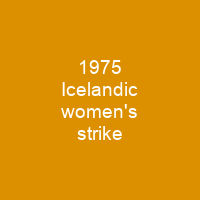On 24 October 1975, Icelandic women did not go to their paid jobs nor did they do any housework or child-rearing at home. Ninety percent of Iceland’s female population participated in the strike. Iceland’s parliament passed a law guaranteeing equal pay the following year. Every ten years on the anniversary of the Day Off, women stop work early.
About 1975 Icelandic women’s strike in brief
 On 24 October 1975, Icelandic women did not go to their paid jobs nor did they do any housework or child-rearing at home. Ninety percent of Iceland’s female population participated in the strike. Iceland’s parliament passed a law guaranteeing equal pay the following year. Every ten years on the anniversary of the Day Off, women stop work early. The International Women’s Strike, a global version inspired by the Icelandic strike, spread in 2017 and 2018.
On 24 October 1975, Icelandic women did not go to their paid jobs nor did they do any housework or child-rearing at home. Ninety percent of Iceland’s female population participated in the strike. Iceland’s parliament passed a law guaranteeing equal pay the following year. Every ten years on the anniversary of the Day Off, women stop work early. The International Women’s Strike, a global version inspired by the Icelandic strike, spread in 2017 and 2018.
The 2016 Black Monday in Poland was modelled on the 1975 Icelandic strike. The strike paved the way for the election of Vigdís Finnbogadóttir, the first democratically elected female president in the world five years later in 1980. The Day Off had a lasting impact and became known colloquially as \”the long Friday\”.
You want to know more about 1975 Icelandic women’s strike?
This page is based on the article 1975 Icelandic women’s strike published in Wikipedia (as of Nov. 12, 2020) and was automatically summarized using artificial intelligence.







